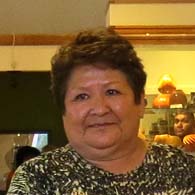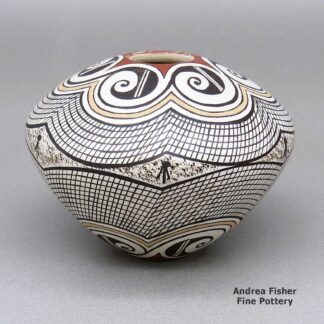Naha, Rainy

Rainy Naha, a member of the Tewa Spider clan, was born to Helen Naha at the village of Hano on Hopi First Mesa in November 1949. Like her siblings Burel and Sylvia, she learned how to make pottery the traditional way: by watching and working with their mother (the original Featherwoman).
Each piece begins with digging and processing the clay and making the slips and paints. When the clay is ready it’s rolled into snakes and hand-coiled and shaped into the form of the pot. Then it’s allowed to dry for a few days. Once a piece is dry and sanded, the white slip is applied. This is a difficult step because if the white slip is not stone polished at the right speed, it will begin to flake and peel off the piece. Finally, the design is painted on the piece and in the final step it is fired outdoors in the traditional manner.
Rainy is methodical in her work and one of her larger pieces, from forming the bowl to firing it, may take 100 or more hours to finish.
It’s Rainy’s intricate designs that make her pieces stand out. She’s also known for making thin walled vessels in both traditional and contemporary shapes.
The designs she paints onto the vessels often incorporate elements of her mother’s work, such as the Awatovi Star and bat wing patterns. However, Rainy also has her own repertoire of images to use.
She is an active long distance runner and often comes across ancient pottery sherds around the ruins of Awatovi when she runs there. Rainy studies these and may incorporate elements of them into her work.
Rainy majored in Archaeology at Brigham Young University and that training allows her to envision where a pot sherd may fit into the structure of the original pot and the design that may have flowed around it. Once she gets that sorted out, she returns the sherds to the Earth.
Parrots, hummingbirds, bear paws and cloud patterns are among Rainy’s additions to her family’s design portfolio. Frequently her pieces have eternity belt design, usually around the neck or shoulder of the bowl. This traditional pattern reflects the continuity of the Hopi-Tewa people. Rainy has also added different colored clay slips to her work with some pieces having up to five different colors!
Rainy has been a participant and earned numerous awards at the Santa Fe Indian Market, the Eight Northern Indian Pueblos Arts and Crafts Show, the Heard Museum Indian Arts Fair & Market and other events since the early 1990s. In 1997 she earned the “Challenge Award for Best Traditional Pottery,” also known as the “Helen Naha (Featherwoman) Award.”
Some Exhibits that featured Rainy’s work
- Artistic Excellence: The Heard Museum Guild Indian Fair & Market Celebrates 60 Years. Heard Museum. Phoenix, Arizona. February 2, 2018 – August 31, 2018
- Elegance from Earth: Hopi Pottery. Heard Museum. Phoenix, Arizona. Opening: March 24, 2012
- Choices and Change: American Indian Artists in the Southwest. Heard Museum North. Scottsdale, Arizona. June 30, 2007 – 2013
- Magic in Clay: Artistic Miniatures of the American Southwest. University of Nebraska State Museum. Lincoln, Nebraska. 1991
Some Awards earned by Rainy
- 2020 Heard Museum Guild Indian Arts Fair & Market: Classification II – Pottery: Honorable Mention for Classification II. Awarded for artwork: “Palhik Mana Dolls” Vase
- 2019 Heard Museum Guild Indian Arts Fair & Market, Classification II – Pottery, Division G – Pottery miniatures not to exceed three (3) inches at its greatest dimension: Honorable Mention. Awarded for artwork: “The Enduring Strength of Women”
- 2019 Heard Museum Guild Indian Arts Fair & Market: Judge’s Award – Ken Williams. Awarded for artwork: “The Enduring Strength of Women”
- 2017 Santa Fe Indian Market, Classification II – Pottery, Division B – Traditional, Category 601 – Painted polychrome pottery in the style of Hopi, any form: First Place
- 2017 Heard Museum Guild Indian Arts Fair & Market, Classification II Pottery, Division A – Painted, Native Clay, Hand Built, Fired Out-of-Doors: First Place. Awarded for Artwork: “Red Star”
- 2015 Heard Museum Guild Indian Arts Fair & Market, Classification II – Pottery, Division A – Traditional – native clay, hand built, painted: Second Place, Honorable Mention
- 2014 Heard Museum Guild Indian Arts Fair & Market, Classification II – Pottery, Division A – Traditional, native clay, hand built, painted: First Place. Awarded for artwork: “Red Star”
- 2013 Heard Museum Guild Indian Arts Fair & Market, Classification II – Pottery, Division A – Traditional, native clay, hand built, painted: Honorable Mention. Awarded for artwork: “Palhik Mana”
- 2011 Heard Museum Guild Indian Arts Fair & Market, Classification II – Pottery, Division A – Traditional, native clay, hand built, painted: Second Place
- 2011 Heard Museum Guild Indian Arts Fair & Market, Classification II – Pottery, Division E – Non-traditional design or form with native materials: Second Place
- 2010 Heard Museum Guild Indian Fair & Market, Classification II – Pottery, Division A – Traditional, native clay, hand built, painted: Second Place
- 2009 Heard Museum Guild Indian Arts Fair & Market, Classification II – Pottery, Division A – Traditional, native clay, hand built, painted: First Place
- 2008 Heard Museum Guild Indian Arts Fair & Market, Classification II – Pottery, Division A – Traditional, native clay, hand built, painted: Second Place
- 2007 Santa Fe Indian Market, Classification II – Pottery: Best of Classification
- 2007 SWAIA Fellowship Award for Pottery
- 2007 Heard Museum Guild Indian Arts Fair & Market, Classification II – Pottery, Division A – Traditional, native clay, hand built, painted: Honorable Mention
- 2006 Heard Museum Guild Indian Arts Fair & Market, Classification II – Pottery, Division A – Traditional-native clay/hand built/painted: First Place
- 2005 Heard Museum Guild Indian Arts Fair & Market, Classification VIII – Pottery, Division A – Traditional/native clay/hand-built (painted): Honorable Mention
- 2004 Santa Fe Indian Market: Special Awards, Helen Naha Memorial Award for Excellence in Traditional Hopi Pottery
- 2004 Santa Fe Indian Market, Classification II – Pottery, Division F – Traditional pottery, painted designs on matte or semi-matte surface, all forms except jars, Category 1301 – Seed bowls, opening must be top center: Third Place
- 2003 Heard Museum Guild Indian Arts Fair & Market: Judge’s Choice Award – Byron Hunter. Awarded for artwork: “Palhik Manas” pottery
- 2001 Santa Fe Indian Market, Classification II – Pottery, Division E – Traditional pottery, jars, painted designs on matte or semi-matte surface, jars, Category 1201 – Jars, Hopi: Second Place
- 2001 Santa Fe Indian Market, Classification II – Pottery, Division F – Traditional pottery, painted designs on matte or semi-matte surface, all forms except jars, Category 1304 – All vase forms including wedding vases: First Place
- 2001 Hopi Marketplace, Pottery Division, Polychrome bowls, jars, vases: First Place. Museum of Northern Arizona
- 2000 Santa Fe Indian Market, Classification II – Pottery, Division E – Traditional pottery, jars, painted designs on matte or semi-matte surface, jars, Category 1201 – Jars, Hopi (up to 6″ tall): First Place
- 2000 Santa Fe Indian Market, Classification II – Pottery, Division E – Traditional pottery, jars, painted designs on matte or semi-matte surface, jars, Category 1202 – Jars, Hopi (over 6″ tall): Third Place
- 2000 Santa Fe Indian Market, Classification II – Pottery, Division F – Traditional pottery, painted designs on matte or semi-matte surface, all forms except jars, Category 1302 – Seed bowls (over 7′ in diameter): Second Place
- 1999 Santa Fe Indian Market, Classification II – Pottery, Division E – Traditional pottery, jars, painted designs on matte or semi-matte surface, jars, Category 1201 – Jars, Hopi (up to 6″ tall): First Place
- 1999 Santa Fe Indian Market, Classification II – Pottery, Division F – Traditional pottery, painted designs on matte or semi-matte surface, all forms except jars, Category 1304 – Other bowl forms (over 9′ in diameter): Third Place
- 1999 Santa Fe Indian Market, Classification II – Pottery, Division F – Traditional pottery, painted designs on matte or semi-matte surface, all forms except jars, Category 1306 – Other vases: First Place
- 1999 Hopi Marketplace: Best of Pottery Division. Museum of Northern Arizona
- 1999 Hopi Marketplace, Pottery Division, Miniatures, Polychrome jars, bowls & vases (under 8″): First Place. Museum of Northern Arizona
- 1999 Hopi Marketplace: Pottery Division, Miniatures, Polychrome jars, bowls & vases (under 8″): Second Place. Museum of Northern Arizona
- 1999 Hopi Marketplace: Pottery Division, Miniatures, Polychrome jars, bowls & vases (under 8″): Third Place. Museum of Northern Arizona
- 1998 Santa Fe Indian Market, Classification II – Pottery, Division E – Traditional pottery, jars, painted designs on matte or semi-matte surface, jars (in the style of Hopi, Acoma, Laguna), Category 1201 – Jars, Hopi (up to 6″ tall): Second Place
- 1998 Hopi Marketplace: Best of Pottery Division. Museum of Northern Arizona
- 1998 Hopi Marketplace, Pottery Division, Polychrome bowls & jars: First Place. Museum of Northern Arizona
- 1998 Hopi Marketplace, Pottery Division, Polychrome bowls & jars: Honorable Mention. Museum of Northern Arizona
- 1998 Hopi Marketplace, Pottery Division, Polychrome jars and bowls, First Place. Museum of Northern Arizona
- 1998 Hopi Marketplace, Pottery Division, Polychrome vases: First Place. Museum of Northern Arizona
- 1997 Santa Fe Indian Market, Challenge Award in Traditional Pottery
- 1997 Hopi Marketplace, Pottery Division, Polychrome seed bowls: First Place. Museum of Northern Arizona
- 1997 Hopi Marketplace, Pottery Division, Polychrome seed bowls: Second Place. Museum of Northern Arizona
- 1997 Hopi Marketplace, Pottery Division, Polychrome canteens, wedding vases: First Place. Museum of Northern Arizona
- 1996 Santa Fe Indian Market, Classification II – Pottery, Division E – Traditional pottery, jars, painted designs on matte or semi-matte surface, jars, Category 1201 – Jars, Hopi (up to 6″ tall): Third Place
- 1996 Santa Fe Indian Market, Classification II – Pottery, Division E – Traditional pottery, jars, painted designs on matte or semi-matte surface, jars, Category 1301 – Seed bowls (up to 7″ in diameter): First Place
- 1996 Santa Fe Indian Market, Classification II – Pottery, Division E – Traditional pottery, jars, painted designs on matte or semi-matte surface, jars, Category 1305 – Wedding vases: Second Place
- 1996 Santa Fe Indian Market, Classification II – Pottery, Division J – Pottery miniatures, 3″ or less in height or diameter, Category 1606 – Traditional forms, vases (including wedding vases), black: First Place
- 1996 Hopi Marketplace: Best of Pottery Division. Museum of Northern Arizona
- 1996 Hopi Marketplace, Pottery Division, Polychrome bowls & jars: First Place. Museum of Northern Arizona
- 1996 Hopi Marketplace, Pottery Division, Polychrome bowls & jars: Honorable Mention. Museum of Northern Arizona
- 1995 Santa Fe Indian Market, Classification II – Pottery, Division F – Traditional pottery, painted designs on matte or semi-matte surface, jars, Category 1301 – Jars, Hopi (up to 9 inches tall): Second Place
- 1995 Santa Fe Indian Market, Classification II – Pottery, Division K – Pottery miniatures, 3″ or less in height or diameter, Category 1702 – Traditional forms-jars, other colors including two-tone: Second Place
- 1995 Hopi Marketplace, Pottery Division – Miniatures: First Place. Museum of Northern Arizona
- 1994 Santa Fe Indian Market, Classification II – Pottery, Division G – Traditional pottery, painted designs on matte or semi-matte surface, all forms except jars, Category 1406 -0ther vases: Third Place
- 1994 Santa Fe Indian Market, Classification II – Pottery, Division G – Traditional pottery, painted designs on matte or semi-matte surface, all forms except jars, Category 1408 – Plates: Third Place
Showing the single result
Showing the single result
